Omron Automatic Blood Pressure Monitor HEM-8712 Instruction Manual

Content
Introduction
The OMRON Automatic Blood Pressure Monitor HEM-8712 is a compact, fully automatic blood pressure monitor, operating on the oscillometric principle. It measures your blood pressure and pulse rate simply and quickly. For comfortable controlled inflation without the need of pressure pre-setting or re-inflation the device uses its advanced “lntelliSense” technology.
The cost of the Omron HEM-8712 is approximately $49.99.
Intended Use
This product is designed to measure the blood pressure and pulse rate of people within the range of the designated arm cuff, following the instructions in this instruction manual.
II is mainly designed for general household use.
Please follow this instruction manual thoroughly.
Please keep for future reference. For specific information about your own blood pressure, CONSULT YOUR DOCTOR.
Technical Data
- Product Description
Automatic Blood Pressure Monitor - Model
HEM-8712 - Display
LCD Digital Display - Measurement Method
Oscillometric method - Measurement Range
Pressure: 0 to 299 mmHg
Pulse: 40 to 180 beats/ min. - Accuracy
Pressure: ±3 mmHg
Pulse: ±5% of display reading - Inflation
Fuzzy-logic controlled by electric pump - Deflation
Automatic pressure release valve - Memory
Last Measurement - Rating
DC6V 4W - Power Source
4 “AA” batteries 1.5V
or AC adapter (optional, INPUT AC100-240V 50/60Hz 0.12A) - Battery Life
Approx. 1000 measurements
(using new alkaline batteries) - Applied Part
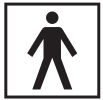 = Type BF
= Type BF - Protection Against Electric Shock
Internally powered ME equipment (When using only the batteries) = Class II ME equipment (Optional AC adapter)
= Class II ME equipment (Optional AC adapter) - Operating temperature/ Humidity
+10 to +40°C / 30 to 85% RH - Storage temperature/ Humidity/ Air pressure
-20 to +60°C / 10 to 95% RH/ 700-1060 hPa - Console Weight
Approx. 250g without batteries - Cuff Weight
Approx. 130g - Outer Dimensions
Approx. 103 (w) mm x 80 (h) mm x 129(l) mm - Cuff Dimensions
Approx. 145 mm x 466 mm
(Cuff: arm circumference 22 to 32 cm) - Cuff/ Tube Material
Nylon, polyester, polyvinyl chloride - Package Contents
Main unit, arm cuff, instruction manual, battery set
NOTE: Subject to technical modification without prior notice.
Important Safety Information
Consult your doctor prior to using in pregnancy or if diagnosed with arrhythmia or arteriosclerosis.
Warning: Indicates a potentially hazardous situation which, if not avoided, could result in death or serious injury.
General Usage
- DO NOT adjust medication based on measurement results from this blood pressure monitor. Take medication as prescribed by your doctor. Only a doctor is qualified to diagnose and treat High Blood Pressure.
- Consult your doctor before using this monitor for any of the following conditions: common arrhythmias such as atrial or ventricular premature beats or atrial fibrillation, arterial sclerosis, poor perfusion, diabetes, age, pregnancy, pre-eclampsia, renal diseases.
- Note that PATIENT motion, trembling, shivering may affect the measurement reading.
- Do not use this monitor on the injured arm or the arm under medical treatment.
- blood Consult your transfusion. doctor before using this monitor on the arm with an arterioÂvenous (A-V) shunt.
- Do not use this monitor with other medical electrical (ME) equipment simultaneously. This may result in incorrect operation of the monitor and/or cause an inaccurate reading.
- Do not use this monitor in the area the HF surgical equipment, MRI, or CT scanner exists, or in the oxygen rich environment. This may result in incorrect operation of the monitor and/or cause an inaccurate reading.
- The air tube or the AC adapter cable may cause accidental strangulation in infants.
- Contains small parts that may cause a choking hazard if swallowed by infants.
- Stop using this monitor and consult your doctor if you experience skin irritation or other troubles.
AC Adapter optional)Usage
- Do not use the AC adapter if this monitor or the power cord is damaged. Tum off the power and unplug the power cord immediately.
- Plug the AC adapter into the appropriate voltage outlet. Do not use a multiple-tap.
- Never plug in or unplug the power cord from the electric outlet with wet hands.
Caution: Indicates a potentially hazardous situation which, if not avoided, may result in minor or moderate injury to the user or patient or damage to the equipment or other property.
General Usage
- Always consult your doctor. Self-diagnosis of measurement results and self-treatment are dangerous.
- Consult your doctor before using monitor for any of the following conditions:
- If you have had a mastectomy or lymph node clearance.
- People with severe blood flow problems or blood disorders as cuff inflation can cause bruising.
- Do not take measurements more than necessary. It may cause bruising due to blood flow interference.
If there are any abnormalities during the measurement, remove the arm cuff. - Do not use this monitor on infants or persons who cannot express their intentions.
- Do not inflate the arm cuff more than necessary.
- Do not use this monitor for any purpose other than measuring blood pressure.
- Use only the approved arm cuff for this monitor. Use of other arm cuffs may result in incorrect measurement results.
- During measurement, make sure that no mobile phone or any other electrical devices that emit electromagnetic fields is within 30cm of this monitor. This may result in incorrect operation of the monitor and/or cause an inaccurate reading.
- Do not disassemble the monitor or arm cuff. This may cause an inaccurate reading.
- Do not use in a location with moisture, or a location where water may splash on this monitor. This may damage this monitor.
- Do not use this monitor in a moving vehicle (car, airplane).
Battery Usage
- Do not insert the batteries with their polarities incorrectly aligned.
- Use only four “AA” alkaline or manganese batteries with this monitor. Do not use other types of batteries. Do not use new and used batteries together.
- Remove the batteries if this monitor will not be used for 3 months or more.
- Use the battery within recommended period mentioned to it.
AC Adapter optional Usage
Fully insert the power plug.
- When disconnecting the power plug, do not pull the power cord. Be sure to hold the power plug.
- When handling the power cord, observe the following:
- Do not damage. Do not break it.
- Do not tamper with it. Do not forcibly bend or pull.
- Do not twist. Do not bundle during use.
- Do not pinch. Do not place under heavy objects.
- Wipe the dust off from the power plug.
- Disconnect the power plug if the product will not be used for a long period of time.
- Disconnect the power plug before starting maintenance.
- Use only the original AC adapter designed for this monitor. Use of unsupported adapters may damage and/or may be hazardous to this monitor.
General Precautions
- Do not forcibly bend the arm cuff or bend the air tube excessively.
- Do not fold or kink the air tube while taking a measurement. This may cause harmful injury by interrupting blood flow.
- To unplug the air plug, pull on the air plug at the connection with the monitor, not the tube itself.
- Do not apply strong shocks and vibrations to or drop the monitor and arm cuff.
- Do not inflate the arm cuff when it is not wrapped around your arm.
- Read and follow the “Important information regarding Electromagnetic
- Compatibility (EMC)” in the “6. Technical Data”.
- Read and follow the “Correct Disposal of This Product” in the Technical Data Section when disposing of this monitor and any used accessories or optional parts.
- Do not use this monitor outside the specified environment. It may cause an inaccurate reading.
- Dispose of this monitor, components and optional accessories according to applicable local regulations. Unlawful disposal may cause environmental pollution.
- Please check (for example, by observation of the limb concerned) if this monitor is not causing a prolonged impairment of PATIENT blood circulation.
- If this monitor is stored at the maximum or minimum storage and transport temperature and is moved to an environment with a temperature of 20° c, we recommend waiting for approx. 2 hours before using the monitor.
Overview
Main unit
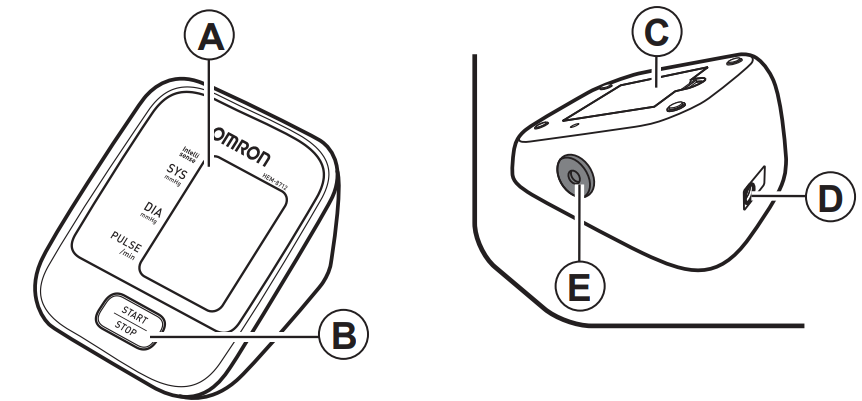
- Display
- START/STOP button
- Battery compartment
- AC adapter jack (for optional AC adapter)
- Air jack
Arm cuff

Display
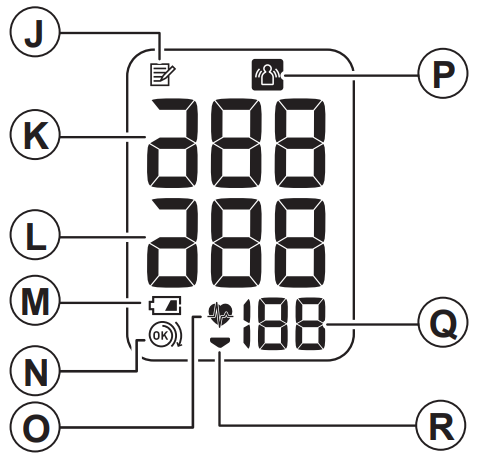
- J. Systolic blood pressure
- L. Diastolic blood pressure
- M. Low battery symbol
- N. Cuff wrapping guide
- 0. Heartbeat symbol
- Flashes during measurement.
- If flashing after measurement completed or when viewing results stored in the memory, indicates blood pressure out of recommended range
- P. Movement error symbol
- Q. Pulse display
- R. Deflation symbol
Omron Automatic Blood Pressure Preparation
Installing/Replacing the Batteries
- Remove the battery cover.
- Insert four “AA” batteries as indicated in the battery compartment and then replace the battery cover

Notes
- If the low battery symbol (
 ) appears on the display, tum the monitor off then replace all batteries at the same time.
) appears on the display, tum the monitor off then replace all batteries at the same time. - The measurement values continue to be stored in memory even after the batteries are replaced.
- The supplied batteries may have a shorter life.
Disposal of used batteries should be carried out in accordance with the national regulations for the disposal of batteries.
Description
The Omron Automatic Blood Pressure Monitor HEM-8712 is designed with convenience and accuracy in mind. The device comes with a contoured cuff that fits standard to large arms, ensuring a comfortable fit for most users. The monitor itself is compact and lightweight, making it easy to store and transport. The HEM-8712 also includes a blood pressure classification indicator, which helps users understand their readings based on the World Health Organization's classification chart. This feature is particularly useful for those who are new to monitoring their blood pressure.
Using the Monitor
Applying the Arm Cuff
Remove tight-fitting clothing or tight rolled up sleeve from your upper arm. Do not place the arm cuff over thick clothes
- Plug the arm cuff into your monitor by inserting the air plug into the air jack securely until it clicks.
Put your arm through the cuff loop.
The bottom edge of the arm cuff should be 1 to 2 cm above the elbow. Marker (arrow under the air tube) is centred on the middle of your inner arm.
Close the fabric fastener FIRMLY
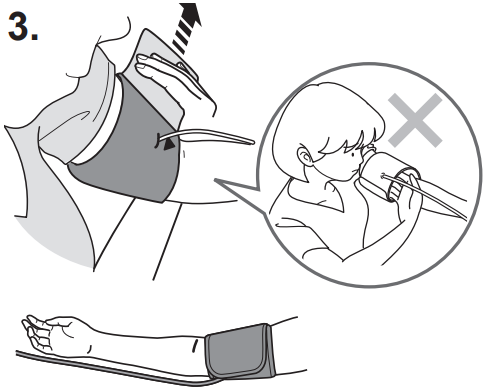
Notes
- When you take a measurement on the right arm, the air tube will be at the side of your elbow. Be careful not to rest your arm on the air tube.
- The blood pressure can differ between the right arm and the left arm, and therefore also the measured blood pressure values can be different. OMRON recommends to always use the same arm for measurement. If the values between both arms differ substantially, please check with your doctor which arm to use for your measurement
How to Sit Correctly
To take a measurement, you need to be relaxed and comfortably seated at comfortable room temperature.
- Sit in a chair with your legs uncrossed and your feet flat on the floor.
- Sit with your back and arm being supported.
- The arm cuff should be placed on your arm at the same level as your heart .

Taking a Reading
Notes
- To cancel a measurement, press the START/STOP button to release the air in the arm cuff.
- Remain still and do not talk while taking a measurement.
Press the START/STOP button.
The arm cuff will start to inflate automatically.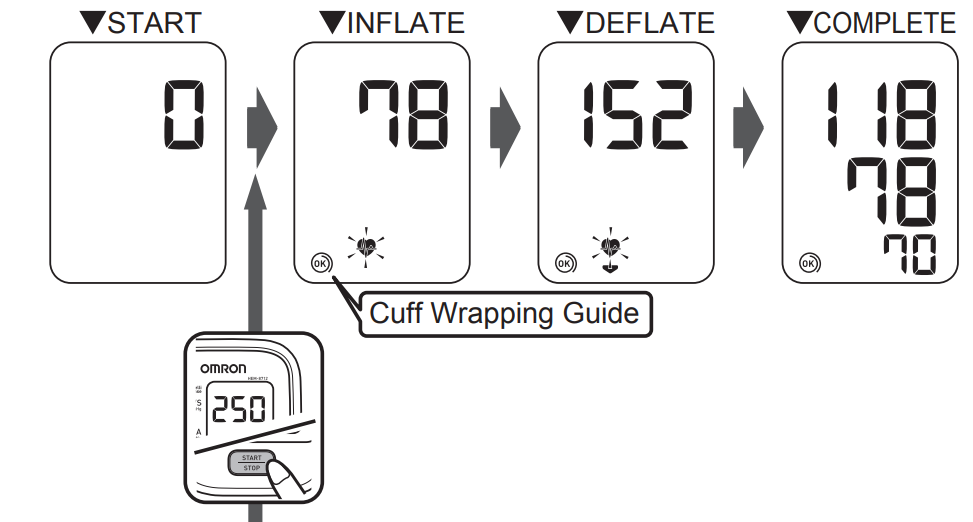
If your systolic pressure is more than 210 mm Hg
After the arm cuff starts to inflate, press and hold the START/STOP button until the monitor inflates 30 to 40 mmHg higher than your expected systolic pressure.Notes
- The monitor will not inflate above 299 mmHg.
- Do not apply more pressure than necessary.
Note: Wait 2-3 minutes before taking another blood pressure measurement. Waiting between readings allows the arteries to return to the condition prior to taking the blood pressure measurement.
WARNING: Always consult your doctor. Self-diagnosis of measurement results and self-treatment are dangerous.
Cuff Wrapping Guide: The Cuff Wrapping Guide is a unique feature that indicates if the cuff is not wrapped tightly enough around the arm. Even when the
 appears on the display, a blood pressure reading will be taken.
appears on the display, a blood pressure reading will be taken.Note: This reading is NOT reliable due to the incorrect wrapping of the cuff. Please wrap the cuff again, taking care to wrap it correctly and take the measurement again. When the
 is displayed, the cuff is correctly wrapped tightly enough on the arm and the reading is accurate and reliable.
is displayed, the cuff is correctly wrapped tightly enough on the arm and the reading is accurate and reliable.Remove the arm cuff
Press the START/STOP button to turn the monitor off.
The monitor automatically stores the measurement in its memory. It will automatically tum off after 2 minutes.
Important:
If your systolic or diastolic pressure is outside the standard range, the heartbeat symbol will blink when the measurement result is displayed. Recent research suggests that the following values can be used as a guide to high blood pressure for measurements taken at home.
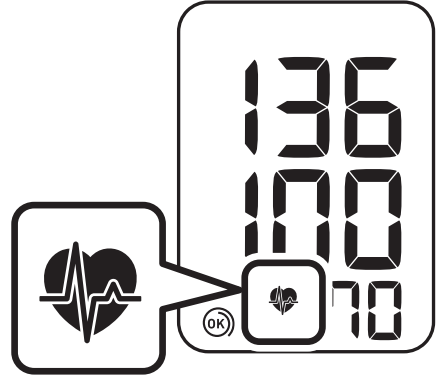
Systolic Blood Pressure: Above 135 mmHg
Diastolic Blood Pressure: Above 85 mmHg
This criteria is for home blood pressure measurement
If you move during measurement, the movement error symbol ( ) will appear on the display. Keep still and repeat the measurement
) will appear on the display. Keep still and repeat the measurement
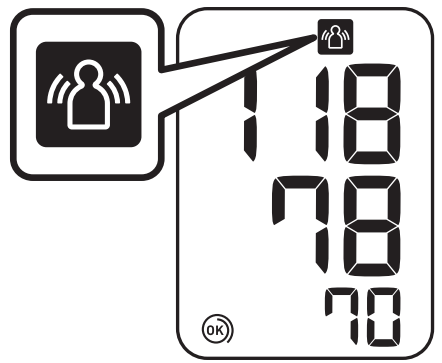
Using the Memory Function
The monitor automatically stores the last measurement values (blood pressure and pulse rate).
To View the Readings Stored in Memory
- Press and hold the START/STOP button for more than 5 seconds.
- The last measurement value is displayed along with the memory symbol.
Notes- If your systolic or diastolic pressure is outside the standard range, the heartbeat symbol will blink when the measurement result is displayed.
- The cuff wrapping guide result appears on the display with the measurement values.
- If there are no measurements results stored in the memory, the screen to the right is displayed
- The last measurement value is displayed along with the memory symbol.
Press the START/STOP button to turn the monitor off. It will automatically turn off after 2 minutes.

To Delete the Values Stored in Memory
Press and hold the START/STOP button for more than 15 seconds.
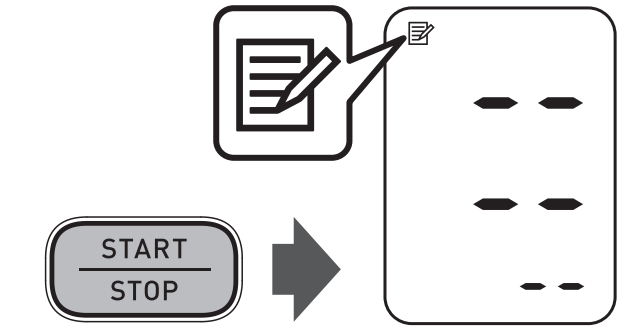
Setup Guide
Setting up and using the Omron HEM-8712 is straightforward. Here’s a step-by-step guide:
- Place the cuff around your upper arm at heart level.
- Sit comfortably and relax your arm on a table or flat surface.
- Press the start button; the monitor will inflate the cuff automatically.
- Wait for the measurement to complete; the device will deflate the cuff and display your blood pressure and pulse rate.
- Refer to the user manual for detailed instructions on positioning, measurement timing, and interpreting results.
Maintenance
To protect your monitor from damage, please observe the following:
- Do not subject the monitor and the cuff to extreme temperatures, humidity, moisture or direct sunlight.
- Do not fold the cuff or tubing tightly.
- Do not inflate the arm cuff over 299 mmHg.
- Do not disassemble the monitor and components.
- Do not subject the monitor to strong shocks or vibrations (for example, dropping the monitor on the floor).
- Do not use volatile liquids to clean the monitor.
- Do not wash the arm cuff or immerse it in water.
- Do not use petrol, thinners or similar solvents to clean the arm cuff.
Do not carry out repairs of any kind yourself. If a defect occurs, consult your local OMRON representative.
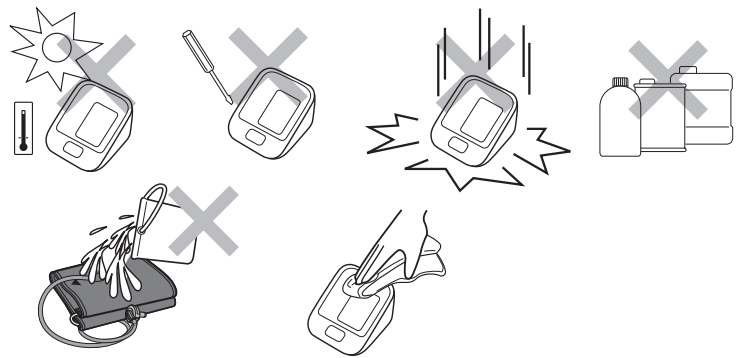
- The monitor should be cleaned with a soft, dry cloth.
- Use a soft, moistened cloth and neutral soap to clean the arm cuff.
Note: Read and follow the “Correct Disposal of This Product” in the Read and follow the “Correct Disposal of This Product” in the Technical Data Section when disposing of the monitor and any used accessories or optional parts.
Calibration and Service
The accuracy of this blood pressure monitor has been carefully tested and is designed for a long service life.
It is generally recommended to have the device inspected every two years to ensure correct functioning and accuracy. Please consult your local OMRON representative.
Storage

- Remove the arm cuff from the monitor.
The air plug is firmly connected not to come off accidentally.
When removing the arm cuff from the monitor, pull the air plug in a straight way from the air jack. It clicks during pulling out. Gently fold the air tube into the arm cuff
Notes
- Do not bend the air tube excessively.
- Do not store your monitor and other components in the following situations:
- If your monitor and other components are wet.
- Locations exposed to extreme temperatures, humidity, direct sunlight, dust or corrosive vapours.
- Locations exposed to vibrations, shocks or where it will be at an angle.
Optional Parts

Note: Do not throw the air plug away. The air plug can be applicable to the optional cuff.
Notes
- Please check with your local OMRON representatives for the appropriate optional parts.
- Please use AC Adapter HHP-OH01 in Australia and New Zealand.
- Please use AC Adapter HHP-BH01 in India.
Using the Optional AC Adapter
Note: Make sure to use an easily accessible power socket in which to START INFLATE DEFLATE COMPLETE connect and disconnect the AC adapter.
- Insert the AC adapter plug into the AC adapter jack on the rear side of your monitor.
- Plug the AC adapter into an electrical outlet.

To disconnect the AC adapter, unplug the AC adapter from the electrical outlet first and then remove the AC adapter plug from the monitor.
Troubleshooting
The Icons and Error Messages
Error Display | Cause | Remedy |
 | Movement duringmeasurement. | Carefully read and repeat thesteps in section3.3. |
Cuff is not appliedcorrectly. | Apply the arm cuff correctly. | |
The batteries are low. | You shouldreplace them with new ones ahead of time | |
Thebatteries are exhausted. | You shouldreplace them with new ones at once. | |
| E1 |
Air plug disconnected. | Insert the plug securely |
Arm cuff not appliedcorrectly. | Apply the arm cuff correctly | |
Air is leaking from the arm cuff. | Replace the cuff with the new one. | |
| E2 |
Movement duringmeasurement and the arm cuff has not been inflated sufficiently. | Repeat measurement. Remain still anddo not talkduring measurement. |
If “E2” appears repeatedly, inflate the cuff manually until it is 30 to 40 mmHg above your previous measurement result. | ||
| E3 | The arm cuff was inflated above 299 mmHg when inflating the cuff manually. | Do notinflate the cuffabove 299 mmHg. |
| E4 |
Movement duringmeasurement. | Repeat measurement. Remain still anddo not talkduring measurement. |
| E5 |
Clothing is interfering with the arm cuff. | Remove any clothing interfering withthe arm cuff. |
| Er | Device error. | Contact your localOMRON representative. |
Troubleshooting
Problem | Cause | Remedy |
The reading is extremely low(or high). |
Arm cuff not appliedcorrectly. | Apply the arm cuff correctly. |
Movement or talking during measurement. | Remain stilland do not talk duringmeasurement. | |
Clothing is interfering with the arm cuff. | Remove any clothing interfering withthe arm cuff. | |
Arm cuffpressure does not rise. | The air tube is not securely connected into the main unit. | Make surethat the air tube is connected securely. |
Air is leaking from the arm cuff. | Replace the arm cuff with a new one. | |
Arm cuff deflates too soon. |
The arm cuff is loose. | Apply the cuff correctly so that it is firmly wrapped aroundthe arm. |
Cannot measure or readings are too low or too high. |
The arm cuff has not been inflated sufficiently. | Inflate the cuff so that it is 30 to 40 mmHg aboveyour previous measurement result. |
Nothing happenswhen you pressthe buttons. | The batteries are empty. | Replace thebatteries with new ones. |
The batteries have been inserted incorrectly. | Insert the batteries with the correct(+/-) polarity. | |
Other problems. |
measurement.
batteries with new ones. If this still does not solve the problem, contact your local OMRON representative. | |
Monitor HEM-8712 Pros & Cons
Pros
- High accuracy due to IntelliSense technology.
- Easy one-touch operation.
- Memory storage for tracking progress.
- Compact and lightweight design.
- Affordable price point compared to other advanced monitors.
Cons
- Limited to standard/large cuff size; may not fit extra-large arms.
- No wireless connectivity or mobile app integration.
- Batteries may need frequent replacement if used extensively.
Customer Reviews
Customers have generally praised the Omron HEM-8712 for its ease of use and accuracy. Many users appreciate its large display and the ability to track their blood pressure over time. However, some have noted that the cuff may not fit comfortably for those with larger arms.
Common Complaints
Some users have reported issues with cuff sizing and occasional inaccuracies if not used correctly. However, these complaints are relatively rare compared to the overall positive feedback.
Faqs
What is the recommended arm size for using the Omron HEM-8712?
How accurate is the Omron HEM-8712 compared to other blood pressure monitors?
Can I use this monitor if I have a pacemaker or other implantable medical device?
How many readings can the Omron HEM-8712 store in its memory?
Is there a way to transfer data from the Omron HEM-8712 to a computer or mobile app?
What are some common reasons for inaccurate readings on the Omron HEM-8712?
How often do I need to replace the batteries in the Omron HEM-8712?
Can I use this monitor while sitting or standing?
Is there any warranty provided with the purchase of the Omron HEM-8712?
Can I purchase additional cuffs for different arm sizes if needed?
Leave a Comment


